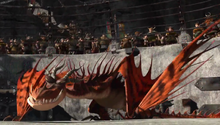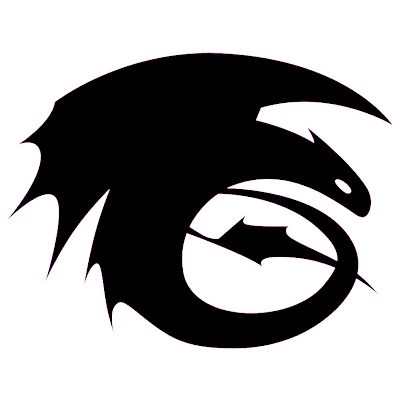|

The Monstrous Nightmare, one of the more common species of dragon.
Dragons are the Barbaric Archipelago's (perhaps even Earth's) second dominant species, a race of powerful reptiles with two distinguishing characteristics: flight and fire generation, although not all dragons have both or either. They are a largely diverse group with many different features, varying throughout all species, and may consist of many orders on a taxonomic level. Most dragons can be tamed and have human companions.
They are the main characters in the How to Train Your Dragon franchise.
Appearance
Dragons come in many different shapes, colors, and sizes.
Most dragons also have protruding teeth from their lower mandible. There are many different species ranging in size, shape, color, and abilities, from the lizard-sized Fireworm to the gargantuan Bewilderbeast.
Some dragon species can have different colored scales amongst individual specimens (such as the Deadly Nadder, Gronckle, Monstrous Nightmare, Hideous Zippleback, and the Thunderdrum etc.) while some retain the same color throughout their breed (such as the Night Fury and the Snow Wraith etc.) Most dragons change their color in their Titan Wing stage in Dragons: Rise of Berk. Some lead individuals, take for example the Night Terrors and Speed Stingers, have different colors based on their social rank. The lead Terror is white instead of black like the rest and the lead Stinger has a red crown and stripes. See Also: Color Varieties
Anatomy
Main article: Dragon Anatomy
They are most likely warm-blooded. Strong evidence of this is the fact they live up in the cold north, and also that some species (such as the Gronckle, Scauldron, Hotburple and the Catastrophic Quaken) are able to take in things from their environment like geological minerals and water and produce enough internal heat to melt and/or boil the materials, while others (such as the Bewilderbeast, Shivertooth, Groncicle, Woolly Howl and the Snow Wraith) are able to cool water down or produce ice.
They have different types of firepowers, ranging from fire to ice, sonic sounds to acid, electricity to water. See Also:Fire Types
Diet
While the natural diet of most dragons is fish, they will happily eat other things, such as vegetables, and man-made food like bread. Most dragons, however, eat fish like mackerel and Atlantic cod, and sometimes other forms of meat. The Monstrous Nightmare and the Changewing have been shown hunting wild boars. The Whispering Death and the Skrill also enjoy eating sheep, so it may be that at least some of the other larger, land-based species do also. The Typhoomerang enjoys eating eels and the Deadly Nadder likes chicken. Some dragons like the Red Death, Scauldron, and Deathsong eat other dragons. Some dragons even eat invertebrates and small animals, as shown by a Raincutter eating grubs and a Razorwhip enjoying Sea Slugs. During the war with the dragons, it is fairly clear that they were also willing to prey on humans, as a Monstrous Nightmare swallowed Gobber's arm and enjoyed it. The trained dragons on Berk will not hunt farm animals, but they will accept their cooked meat if given to them by humans.
Dragons also enjoy vegetables and plants. Deadly Nadders have been shown feasting on a type of bush or shrub. The Flightmare eats algae suspended in water, which other dragons can also eat. The Scauldron enjoys the Blue Oleander Flowers that give its species venom. Dragon Root and Dragon Nip are plants that dragons eat. The Dragon Root is loved by dragons and can make them wild and fight over it. Only the Gronckle is immune to it. The Dragon Nip, on the other hand, soothes the wild dragons. The Monstrous Nightmare has been shown eating corn. The dragons also like Sagefruit, which is said that has the same effects as the Dragon Nip.
Some can also eat other substances, such as the Gronckle, which eats rocks for food and to convert to the lava they fire, and the Hotburple eats metal ores. The Gronckle can produce a variety of lava or metals after eating different rocks, such as lava rocks, Gronckle Iron, magnets, different colored lava and a transparent material. Snafflefangs enjoy eating geodes. Toothless has been seen snatching bread from Hiccup.
Predators and Weaknesses
Dragons have three major predators: healthy adults can be in danger from rival dragons and humans, and wild boars prey on young and injured dragons. Most species are susceptible to the toxic pollen of Blue Oleander, have a fear of eels and limited number of 'shots', as well as a blind spot.
Behavior and Personality
Dragons are a tribal-level creatures, living in large colonies with their own kind and other dragon species. A large dragon like a Red Death or Bewilderbeast normally controls the nest as an alpha. Alphas control dragons either by earning their trust and loyalty by protecting them, or scaring them into submission. They gather together to mate and lay eggs. These behaviors have also moved on to other species such as humans, as well as domesticated animals like sheep, cattle and chickens, thanks to the training and semi "domesticating" of dragons. It is unknown whether they mate for life or not. Some dragons like the Flightmare, however, prefer hunting and living alone.
The average trained dragons are loyal to their owners and most will protect them when they are in danger. They will do anything to earn their trust and will not leave them.
Life Cycle
The Book of Dragons shows that there are five stages in a dragon's growth: Egg, Tiny Tooth, Short Wing, Broad Wing, and the incredibly rare Titan Wing.
- Egg: Dragon eggs come in a wide variety of shapes, size and color, all of which help the egg survive better. Some of which even explode when hatching. Dragons on Berk head to The Berkery every Snoggletog to lay eggs. See Also: Dragon Eggs.
- Tiny Tooth: Also known as the hatchling or baby in Rise of Berk, these dragons are small and extremely adorable. See Also: Baby Dragons
- Short Wing: Also known as the juvenile or teen stage in Rise of Berk, these dragons are slightly smaller than their full grown size. They start to develop traits and characteristics of their species, but their firepower may be weaker. For example, juvenile Speed Stinger venom only paralyses some body parts instead of the entire body and for a shorter time.
- Broad Wing: These adults are fully grown and have developed all traits of their species.
- Titan Wing: Titans are the rarest stage of dragons. They are physically faster and stronger than their younger counterparts, with different colors and more body parts like spikes and barbs in Rise of Berk. They are significantly larger and may tend to bully younger dragons, as seen in "Total Nightmare". Though Titans may have the upper cut, it does not mean that they are undefeatable. They are less agile due to their size, and can be defeated by several adults. They are still powerful dragons. See Also: Titan Wing Dragons
Fate
Based on comments by Dean DeBlois, just like in the books, the dragons in the franchise share the same fate, as they all go into hiding.
Taxonomy and Classification
Main article: Dragon Classes (Franchise)
Dragons are in the class Reptilia and are further classified into different "classes" by the Hairy Hooligans Tribe. These classes are not based on the shared characteristics of the dragons, but rather the similarities of certain abilities or features that the dragons possesses. Dragons can be moved to another class if new discoveries are made that would better fit the dragon in another class. These classes include:
- Stoker Class
- Boulder Class
- Tracker Class
- Sharp Class
- Tidal Class
- Mystery Class
- Strike Class
Trivia
- In the game Dragons: Rise of Berk, the dragons can be trained further by Valka to allow them to change to the final stage of a dragon's growth, the Titan Wing.
- It can be observed that, apart from growing in size, the color of the dragon's scales greatly changes, with only a few parts of its body unchanged.








